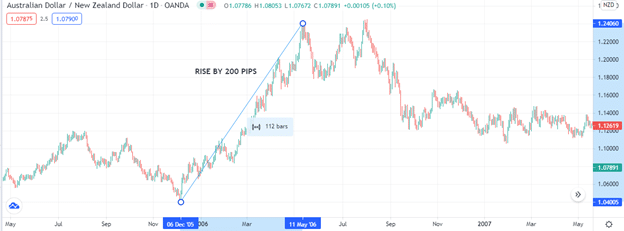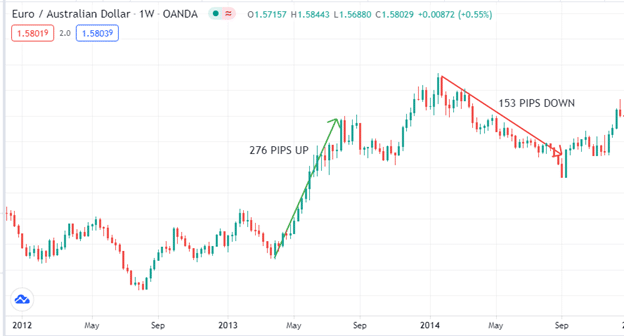Traders often find profit-making opportunities in currency pairs without the U.S. dollar. A cross-currency pair refers to a pair of currencies that lacks the United States dollar. The dollar is very liquid and is the most traded currency in the world. However, there are times when other currencies offer more profitable opportunities.
The basic principle behind cross-currency trading is that when combined with major pairs, cross currencies offer a far much higher number of trading opportunities than other approaches. Economic interdependence between nations creates a corresponding interrelationship between their currencies.
For example, GBP and the euro were closely related during the United Kingdom’s membership in the European Union. This was because the British economy was significantly impacted by the European Union’s economic policies. However, following Brexit, the British pound is likely to be increasingly detached from the euro.
For highly correlated pairs, it is necessary to employ technical indicators that can capture their interrelationship. For example, you could use the RSI or the Bollinger Bands to trade during the range.
How to calculate currency cross rates
Attention to the smallest of numbers is of utmost importance when trading cross currencies.
For example, we could be interested in the EUR/GBP pair. To get the bid price for EUR/USD, we will need to find the bid/ask prices for EUR/USD and GBP/USD. The two pairs have been chosen because the USD is the quoted currency for both.
EUR/USD: 1.1356 (bid)/1.1358 (ask)
GBP/USD: 1.4112 (bid)/1.4116 (ask)
Therefore, to get the bid price for EUR/GBP, we divide the bid price for the base currency by the ask price for the quoted currency. This works out as shown below:
Bid price for EUR/USD = 1.1356/1.4116 = 0.8044
However, the EUR/USD pair is also quoted differently.
We calculate the ask rate by dividing the ask rate for the base currency by the bid rate for the quote currency. This works out as below:
Ask price for EUR/GBP = 1. 1358/1.4112 = 0.8048
Choosing a currency cross pair: how do you know which one is worthwhile?
There are three main types of cross currency pairs.
Firstly, you can have pairs with major global currencies such as the Japanese yen, the euro, the Swiss franc or the British pound. These are favored by traders because of their high liquidity and low volatility, which makes them stable.
Secondly, there are pairs with minor currencies, whose traded volumes are significantly lower than majors. These pairs lack majors in them, leading to high volatility. As a result of their high volatility, their candlesticks tend to have periodic spikes that make them quite unpredictable. A look at the long candlesticks on the NZD/CAD chart below shows the nature of such “erratic” movements.
Why should you consider trading cross-pairs?
Cross currency trading allows traders to benefit from opportunities presented by fundamentals, such as changes in interest rates. For example, as a result of differentials created by interest rate changes, traders get the chance to trade on factors such as the potential increase in the circulation of a specific currency. As a trader, you can sell currencies from countries whose interest rates have been lowered and buy those whose interest rates have been raised.
Types of cross pairs
1) Correlated cross pairs
There are pairs whose constituent currencies have a closely intertwined relationship. When one appreciates, the other depreciates. Such currencies may also ascend or descend simultaneously under some circumstances. The individual currency pairings against the U.S. dollar help us evaluate the degree of correlation. For example, the close correlation between GBP and EUR in the pre-Brexit era could be confirmed by their movements against the U.S. dollar. Therefore, when the two currencies are paired up, they are relatively stable, compared to others.
Due to their close relationship, correlated pairs tend to trade in a range. The same applies to currencies whose strengths are built on global commodity prices, such as the Australian dollar and the Chilean peso. Common correlated pairs include NZD/CAD, GBP/CHF and AUD/CAD.

2) Uncorrelated cross pairs
These are currencies whose interrelationships are largely weak and whose trades have characteristically high volatility. The highly detached interrelationship is a result of the different economic backgrounds of the currencies’ issuing nations. For example, the currencies of commodity-based economies strengthen when commodity prices appreciate in the global market.
During such times, the currencies of service/industrial-based economies may remain relatively unaffected. This may lead to wide variations and increased volatility when commodity prices fall in subsequent days. For example, EUR/AUD, CAD/JPY, NZD/CAD and GBP/JPY may fluctuate widely as compared to EUR/GBP.
Uncorrelated pairs may move by hundreds of pips a day, thereby increasing the risk exposure levels. With high swings in pips, the potential profit margins are significantly increased, thus making uncorrelated pairs attractive to many traders.

The difference between currency cross pairs and currency majors
1) Spreads
As a result of their low traded volume, cross pairs have comparatively wider spreads relative to majors. Typically, banks and other major institutions trade their cross pairs by first converting them to the U.S. dollar, thus further boosting the liquidity of the dollar. The variations in spreads of cross pairs also depend on the rates offered by brokers. The large spreads may eat up a significant amount of your funds when trading cross pairs, compared to majors.
2) Correlation
Each cross pair has its unique way of price movements. Some crosses tend to take longer times in the range than others. On the other hand, there are cross pairs that tend to spend most of their price action on the trending trajectory, with fewer instances of retracements. Due to these differences, even the most closely related cross pairs will often depict different correlations with majors. Therefore, you need to bear this in mind when trading cross pairs.
3) Cross pairs have less stable support and resistance levels
Because of their large trading volumes, and as a result of their low volatility, majors tend to establish longer-lasting support and resistance levels. When these levels are breached in majors markets, then there is a high possibility of establishing either an uptrend or a downtrend.
On the other hand, the low interest in trading cross pairs means that the liquidity is low as well. Therefore, any current price support and resistance levels in these pairs tend to be short-lived. This is a peculiar aspect of crosses, which may cause you losses.
Unlike majors, it is quite normal for the breaking of a resistance level in a cross pair to be followed by a downward shift to a lower support level and another upward appreciation beyond the previous resistance level, within a short time.
This may be destabilizing for traders who are unfamiliar with these dynamics. Therefore, you need to incorporate more technical and fundamental aspects of the trade when trading crosses to ensure reliability.
Bottom line
Currency crosses can present you with great opportunities to return decent profits in forex trading. However, they have unique aspects that make them significantly different from major pairs. Therefore you need to master these aspects and appreciate that you will need to trade them using a different approach from trading majors.




